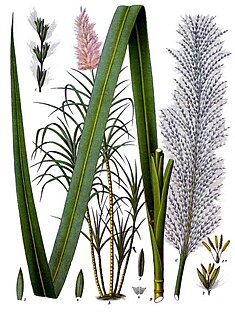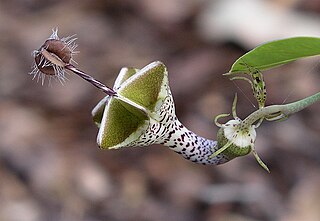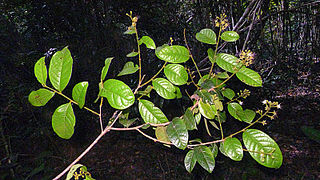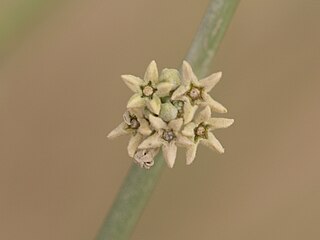
Saccharum is a genus of tall perennial plants of the broomsedge tribe within the grass family.

Ceropegia is a genus of plants within the family Apocynaceae, native to Africa, southern Asia, and Australia. It was named by Carl Linnaeus, who first described this genus in volume 1 of his Species plantarum, which appeared in 1753. Linnaeus thought that the flowers looked like a fountain of wax. From this the scientific name was derived: kērós meaning wax and pēgḗ meaning fountain. They have many common names including lantern flower, parasol flower, parachute flower, bushman’s pipe, string of hearts, snake creeper, wine-glass vine, rosary vine, and necklace vine.

Olea is a genus of about 40 species in the family Oleaceae, native to warm temperate and tropical regions of the Middle East, southern Europe, Africa, southern Asia, and Australasia. They are evergreen trees and shrubs, with small, opposite, entire leaves. The fruit is a drupe. Leaves of Olea contain trichosclereids.

Chrysophyllum is a group of trees in the Sapotaceae described as a genus by Linnaeus in 1753.

Zanthoxylum is a genus of about 250 species of deciduous and evergreen trees, shrubs and climbers in the family Rutaceae that are native to warm temperate and subtropical areas worldwide. It is the type genus of the tribe Zanthoxyleae in the subfamily Rutoideae. Several of the species have yellow heartwood, to which their generic name alludes.

Coreopsis lanceolata, the lance-leaved coreopsis, is a North American species of tickseed in the sunflower family. It is native to the eastern and central parts of the United States and naturalized in Canada, the western United States, Mesoamerica, South America, South Africa and eastern Australia. Under natural conditions, it is found in open woodlands, prairies, plains, meadows, and savannas. The genus name Coreopsis means "bug-like"; it comes from the Greek words "koris", meaning "bug" and "opsis", meaning "like".

Plukenetia is a genus of plant of the family Euphorbiaceae. It is widespread in tropical regions of Africa, the Indian Subcontinent, Southeast Asia, and the Americas.

Rauvolfia is a genus of evergreen trees and shrubs, commonly known as devil peppers, in the family Apocynaceae. The genus is named to honor Leonhard Rauwolf. The genus can mainly be found in tropical regions of Africa, Asia, Latin America, and various oceanic islands.

Cenchrus is a widespread genus of plants in the grass family. Its species are native to many countries in Asia, Africa, Australia, the Americas, and various oceanic islands.

Anthoxanthum, commonly known as hornworts, vernal grasses, or vernalgrasses, is a genus of plants in the grass family.

Cephalanthus is a genus of flowering plants in the family Rubiaceae. There are about six species that are commonly known as buttonbush.

Volkameria is a genus of flowering plants in the family Lamiaceae. It is pantropical in distribution. Many of the species are found in coastal habitats.

Hirtella is a genus of 110 species of woody trees in family Chrysobalanaceae. It was first described as a genus by Linnaeus in 1753. Hirtella naturally occurs in tropical forests throughout Latin America, the West Indies, southeast Africa, and Madagascar. The flowers are mainly pollinated by butterflies.

Mimusops is a genus of plants in the family Sapotaceae described as a genus by Linnaeus in 1753.
Perdicium is a genus of African plants in the gerbera tribe within the daisy family.
Aspidoglossum is a genus of plants in the family Apocynaceae, first described as a genus in 1838. It is native to Africa.

Leptadenia is a genus of plants in the family Apocynaceae, first described as a genus in 1810. It is native to Africa, including Madagascar, as well as southwest Asia and the Indian Subcontinent.
- Leptadenia arborea(Forssk.) Schweinf. - Sudan, Ethiopia
- Leptadenia lancifolia(Schumach. & Thonn.) Decne. - tropical Africa
- Leptadenia madagascariensisDecne. - Madagascar
- Leptadenia pyrotechnica(Forssk.) Decne. - widespread from Algeria to India
- Leptadenia reticulata(Retz.) Wight & Arn. - Madagascar
Pentatropis is a genus of plants in the family Apocynaceae, first described as a genus in 1834. It is native to Africa and southern Asia.
Sphaerocodon is a genus of plants in the Apocynaceae first described as a genus in 1876. It is native to southern Africa.
- Sphaerocodon acutifoliumK.Schum. - Namibia
- Sphaerocodon angolensisS.Moore - Angola
- Sphaerocodon caffrum(Meisn.) Schltr. - Tanzania, Malawi, Zambia
- Sphaerocodon melananthum(K.Schum.) N.E.Br. - Zimbabwe
- Sphaerocodon natalenseBenth. - KwaZulu-Natal
- Sphaerocodon obtusifoliumBenth. - South Africa
- Sphaerocodon platypodumK.Schum. - Katanga in southern Zaire

Bidens bipinnata is a common and widespread species of flowering plant in the daisy family. It is widely dispersed in many lands, so much so that it is difficult to ascertain with certainty its region of origin. It seems most likely, though, that it is native to Asia and North America, and naturalized elsewhere. It is most commonly called by the common name Spanish needles.
















